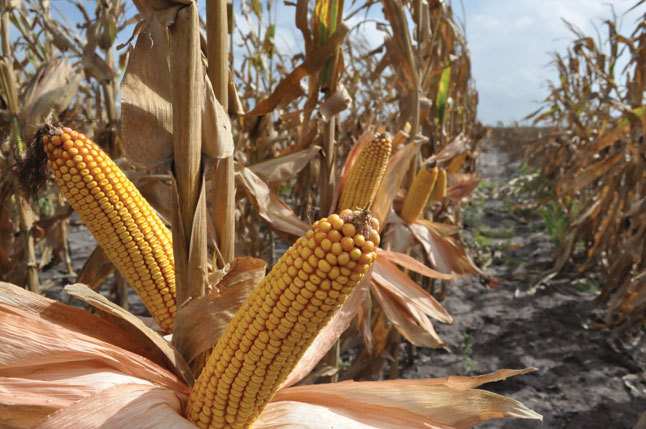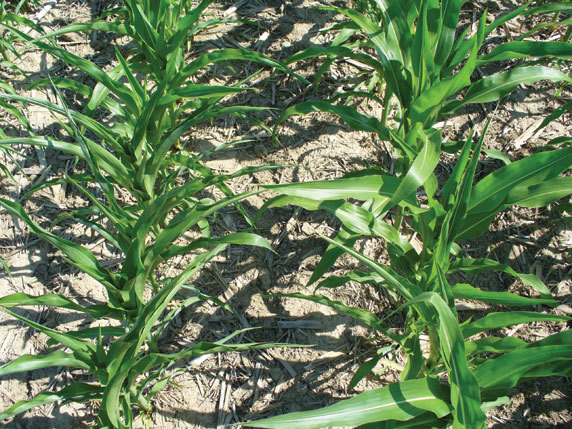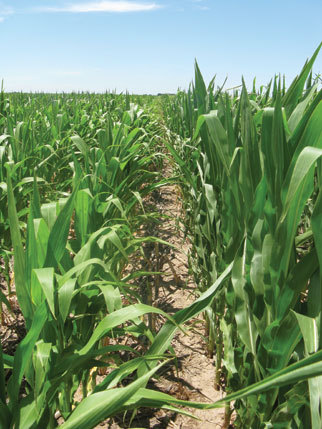Boosting Corn's Drought Performance




PHOTO: MONSANTO
September 11, 2012
BY Susanne Retka Schill
For corn breeders working on drought resistance, 2012 is a year to see just how good the new varieties have become. The three big seed companies—Syngenta, Monsanto Co. and Pioneer—all have widespread farm plots of their new drought-resistant varieties being put to the test. None are claiming their varieties will grow with no rain but all are hoping farmers get a chance to see just what these varieties can do under stress.
Improved drought resistance has long been a goal for the corn seed industry. The big three all launched intensive programs a decade ago to bring better drought-tolerance traits forward. Not long after Pioneer started the effort, the company ran an experiment that showed the improvements that had been made up to that point. “We can recreate any hybrids we’ve ever sold, because we keep the inbreds,” explains Jeff Schussler, senior research manager for maize stress product development at Pioneer. “We took the top three products Pioneer sold in each decade from the 1930s through the past decade and grew them in the same experiment in California under extreme drought like we experienced this year.” The results were reported as bushels of grain produced per inch of water. “We found hybrids in the '30s and '40s could produce roughly 3 bushels of corn per inch of water applied,” he says. “The hybrids in the '90s and 2000s produced about 9 to 10 bushels per inch.”
A three-fold increase over 70 years of breeding is impressive but the new class of drought-resistant corn varieties is leaving those numbers in the dust. After decades of seeing 1 percent yield increases in hybrid advances year over year, the companies are now reporting yield increases of 7 or 15 percent.
Pioneer was the first to release its new crop of drought-resistant hybrids, marketed as Optimum Aquamax, offering five hybrids in 2011 and a total of 25 hybrids in 2012. Around 2 million acres were seeded this spring. While 2012 results won’t be in until after harvest, Pioneer analyzed the drought-stressed locations from more than 8,000 on-farm trails in 2011. “We found in those dry locations where we proved there was a significant drought stress—680 locations in 2011—our Aquamax varieties were out-yielding other hybrids and competitors by 7.1 percent,” Schussler says. “In those other 7,000-plus locations, where it was high yield and there wasn’t a water limitation, the Aquamax products were yielding about 3 percent more than other hybrids it was compared to.”
Advertisement
The improvements with these new varieties are far better than previously expected. “We used to be happy with 1 percent [yield improvement] per year,” says Wayne Fithian, technical product lead at Syngenta. “Part of it was due to improved yield potential but also improved stability. We didn’t approach drought resistance directly because we had the problem of losing top-end potential.”
Syngenta launched its Agrisure Artesian line this year, with 800 plots grown by corn farmers across the Corn Belt from Colorado to Ohio and Kentucky to Minnesota. Syngenta’s Gene Blueprinting program has advanced hybrids with an impressive drought record. “Our promise is up to 15 percent improvement in yield potential in fields affected by moderate to severe drought,” Fithian says. “So in a field that will typically yield 150 bushels and the drought knocks it back to 80 bushels, we’d expect our Artesian hybrid to get 90 to 94 bushels.”
The dramatic improvement in corn yield potential builds on the past work of corn breeders and the advances in molecular biology and genomics, which have recently become far more accessible. Othmar Pfannes, CEO of Genedata AG, a Swiss-headquartered software company, explains that when his company started working with the pharmaceutical industry to analyze gene sequencing data, the technology was extremely expensive. “Ten years ago, to do a genome sequence was a year’s research budget for an entire organization,” he explains. “Now you can do it for a day or two day’s budget. You can sequence on a regular basis and do individual strains.” That comes with an explosion in data, which his software company specializes in analyzing, combining comparisons of genome sequences of chosen individuals with public domain data and cross checking with other company’s intellectual property. In corn breeding, that means the genetic makeup of plants that are performing well can be compared to the genetics of a closely related, poorly performing plant—with the goal of identifying the key genes involved.
Breeding Approaches
New understanding of molecular biology and gene technology has transformed the breeding industry, making it possible for both Syngenta and Pioneer to identify native genes important to drought response and successfully transfer them to new inbred lines, which are the basis of their new hybrids. Both companies are also now working on genetically modified (GM) varieties. On the other hand, Monsanto began its drought development work with GM traits.
Monsanto’s approach to drought resistance is based on its trail-blazing work in inserting transgenetic material into corn, developing herbicide- and insect-resistant corn. The success of those very visible traits, however, creates a bit of a problem for the new drought trait. With Roundup Ready corn, visually, it can be seen that weeds die while the corn lives, says Mark Edge, marketing lead for DroughtGard Hybrids. In Monsanto’s drought and stress resistance work—a collaboration with BASF, a global chemical company—“there’s not a clear delineation of whether the gene is having a direct effect.” In other words, there isn’t a visual difference between corn plants with and without the drought trait. “The effect isn’t seen in the leaves,” he says. “What really matters is not how green or tall or how beautiful the plant looks, but what’s on the ear.” The company selected a gene that affects the plant’s utilization of water, Edge explains, so when the plant is under stress, the sap flow is reduced. “It is pulling less water out of the soil profile and using that water more efficiently.” The single transgenic trait was added to their best varieties, which will include Monsanto's Roundup Ready and insect resistant traits.
Monsanto’s DroughtGard Hybrids were approved this year for use in the U.S. (and pending international import approvals), and are in precommercial testing by 250 growers on about 10,000 acres across the western Great Plains from South Dakota to Texas. Until the federal approval of the GM trait, the company was required to isolate its test plots and destroy the crop following harvest. Monsanto is targeting a 2013 commercial rollout of the new varieties in the western Grain Plains, which experiences more drought stress on a frequent basis, although it will also be available for testing across the Corn Belt.
Advertisement
Syngenta’s program started 10 years ago when it asked scientists to nominate a set of genes that would improve yield potential of corn under drought. A dozen of those genes were validated and the work began to back cross and forward breed, creating new inbreds to use in hybrid development. Syngenta calls its process Gene Blueprinting. “It’s similar to GM in that we are working at the gene level,” Fithian says. “These genes are already in corn, but they are genes that are not widely expressed and not widely expressed in combination.” The 12 genes in their Agrisure Artesian hybrids provide multiple modes of action. “The neat thing is when you can produce multiple modes of action, you have season-long protection. It doesn’t matter when the drought is,” he explains. The selected genes help the plant make proteins and sugars, even when the plant is dehydrated. It also slows down leaf scorching and hastens maturity responses, ultimately helping the plants stay intact for another two or three weeks in drought conditions.
Pioneer’s investments in testing facilities highlights another dimension of developing drought-tolerant varieties—the challenge of screening for drought when Mother Nature is so unpredictable. “It’s typical whenever you try to do these drought experiments in the field, you can be in the most typically dryland area in the world, and if you put a drought experiment there, you get rainfall,” Schussler says wryly. Over a decade ago, Pioneer established a research facility in California’s Central Valley which grows great corn, but only if irrigated. That lack of rain, however, facilitates drought research for which the timing and amount of water applied can be controlled. A similar facility in Chile allows year-round testing. The research plots in such dry climates, Schussler says, “allows us to get a core set of drought data every year for advancing hybrids.” Those lines can then be validated in Pioneer’s original dryland research center in York, Neb., established in the 1950s, along with newer facilities in Texas, Kansas, Colorado and North Carolina. Using whole genome prediction, he says, “We can make predictions of which hybrid cross would be the best for drought, based on the history of the inbred parents and all of our drought data over the past 80 years.” Picking the cream of the crop, “we take them to these field evaluation sites and confirm that these predictions are real and the products are really performing.”
Pioneer has found that the Aquamax varieties maintain green leaf area longer. “In extreme heat conditions, that’s important to keep the plant fixing carbon and make sugar that makes grain,” he says. The varieties are slow in leaf rolling under heat conditions and instead slow down water loss by regulating the stomates—the small holes in the leaves. Another important trait is rapid silking, helping to extend the critically short pollination period that ranges from five days to two weeks. “One of the vulnerabilities of corn is that it has a discrete period when a lot of yield potential is determined very quickly,” he adds.
The goal of all three breeding programs is to enhance the corn plant’s ability to hang in there a little bit longer, in the hopes of catching rain in another two or three weeks. Developing hybrids that perform well under drought stress but didn’t lose top-end yield potential when moisture conditions are perfect has proved just as important. Every year, at some time and some place, corn crops suffer from moisture stress. “Even with the beautiful soils we’ve been blessed with in the heart of the Corn Belt, we can have years like this, with drought, or fields that are not as consistent in water-holding capacity,” says Syngenta’s Fithian. And all companies are looking at the global market, where water is the most limiting factor in most places growing corn.
Setting proper expectations is important, though, says Monsanto’s Edge. “We didn’t create a corn that acts like a cactus, or that you can grow in the Sahara.”
Author: Susanne Retka Schill
Contributions Editor, Ethanol Producer Magazine
(701) 738-4922
sretkaschill@bbiinternational.com
Upcoming Events





